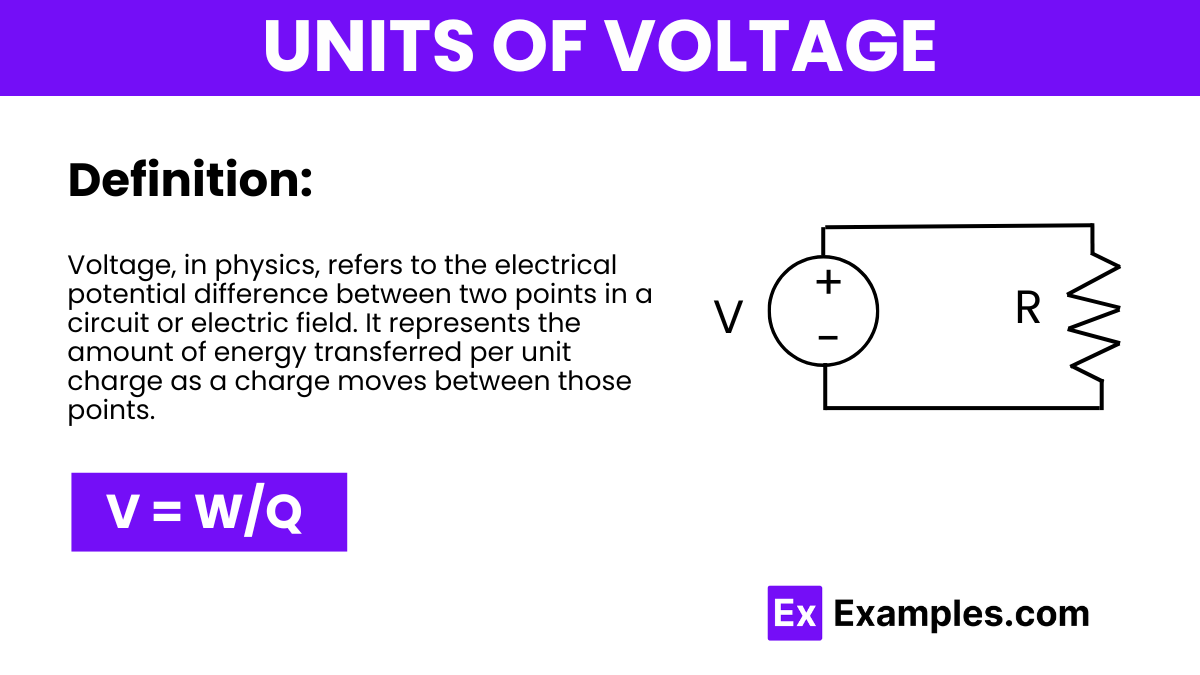What is the unit of voltage?
Ampere
Coulomb
Volt
Ohm


The formula for voltage (V) is:
Where: 𝑉represents voltage (in volts, V)
𝑊 represents the work done or energy transferred (in joules, J)
𝑄 represents the electric charge (in coulombs, C)
Voltage is measured in volts (V), representing electrical potential difference. It determines the flow of electric current in circuits. Common units include millivolts (mV) and kilovolts (kV). Voltage is essential in powering electrical devices and systems.
| Unit | Symbol |
|---|---|
| Volt | V |
| Millivolt | mV |
| Microvolt | μV |
| Kilovolt | kV |
| Megavolt | MV |
| Gigavolt | GV |
| Picovolt | pV |
| Nanovolt | nV |
| Statvolt | statV |

| From Unit | To Unit | Conversion Formula |
|---|---|---|
| Volt (V) | Millivolt (mV) | millivolts = volts × 1000 |
| Millivolt (mV) | Volt (V) | volts = millivolts / 1000 |
| Volt (V) | Kilovolt (kV) | kilovolts = volts / 1000 |
| Kilovolt (kV) | Volt (V) | volts = kilovolts × 1000 |
| Volt (V) | Megavolt (MV) | megavolts = volts / 1,000,000 |
| Megavolt (MV) | Volt (V) | volts = megavolts × 1,000,000 |
Volt (V) to Millivolt (mV):
Millivolt (mV) to Volt (V):
Volt (V) to Kilovolt (kV):
Kilovolt (kV) to Volt (V):
Volt (V) to Megavolt (MV):
Megavolt (MV) to Volt (V):
To convert megavolts to volts, multiply the voltage value by 1,000,000.
One volt is equal to the electrical potential difference between two points when one joule of energy is transferred per coulomb of charge moved between those points.
The four basic units of electricity are voltage (volts), current (amperes), resistance (ohms), and power (watts). These units are fundamental in electrical calculations and circuit analysis.
Another term used for voltage is electric potential difference, which represents the energy per unit charge required to move a charge between two points in an electric field. Voltage is also sometimes referred to as electromotive force (EMF).
Text prompt
Add Tone
10 Examples of Public speaking
20 Examples of Gas lighting
What is the unit of voltage?
Ampere
Coulomb
Volt
Ohm
Which of the following represents 1 volt?
1 joule per coulomb
1 watt per ampere
1 coulomb per second
1 ampere per ohm
How is the potential difference measured?
Using an ammeter
Using a voltmeter
Using an ohmmeter
Using a wattmeter
What is the unit of electromotive force (emf)?
Volt
Ampere
Watt
Ohm
Which device converts mechanical energy to electrical energy and generates voltage?
Transformer
Battery
Generator
Resistor
If a battery provides a voltage of 12 V, what is the potential difference across its terminals?
6 V
12 V
24 V
36 V
Which of the following represents millivolts?
mA
mV
mΩ
mW
What is the voltage across a resistor if a current of 2 A flows through it and its resistance is 5 Ω?
2.5 V
5 V
10 V
15 V
Which of the following instruments is used to measure voltage in a circuit?
Galvanometer
Ammeter
Voltmeter
Thermometer
What is the SI unit for voltage?
Volt
Ampere
Ohm
Coulomb
Before you leave, take our quick quiz to enhance your learning!

